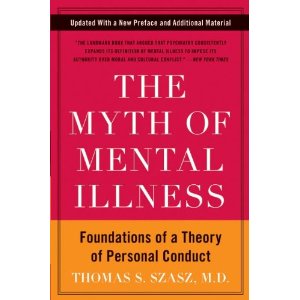 Adams, W. A. (2011). Words Matter: The Legacy of Thomas Szasz
Adams, W. A. (2011). Words Matter: The Legacy of Thomas Szasz
[Review of the book, The Myth of Mental Illness: Foundations of a Personal Theory of Conduct, 50th Anniversary Edition]. PsycCRITIQUES – Contemporary Psychology: APA Review of Books, March 9, 2011 (56), Release 10, Article 8.
Spring fever is not really a fever, homesickness is not really sickness, and mental illness is not really illness. That’s the argument of Thomas Szasz, professor emeritus of psychiatry at the State University of New York in Syracuse. He has been repeating and elaborating that message since publication of his iconoclastic book, The Myth of Mental Illness (Szasz, 1961).Szasz does not deny that some people have serious psychological problems. But there are so many difficulties with the term, the concept, and the psychiatric approach to “mental illness” that he wants no part of it.
The new preface in this 50th anniversary edition is a succinct yet lively summary of Szasz’s position, and could serve as a standalone introduction to his ideas, attitudes, and bombastic style. He asserts, “The claim that ‘mental illnesses are diagnosable disorders of the brain’ is not based on scientific research; it is a lie, an error, or a naive revival of the somatic premise of the long-discredited humoral theory of disease” (p. xii). Szaszian rhetoric does not countenance qualification, accommodation, or counterargument: those who disagree are naïve, mistaken, or liars.
A pugnacious style can be entertaining, but Szasz makes numerous rhetorical errors that seriously detract from important points he wants to make, errors such as circular arguments and unbalanced presentation of evidence. He rejects all behavioral evidence of illness, for example. If there is no demonstrated physical pathology, there is no illness, period. That oversimplification leads to implausible claims, such as, since there is no clear biological determinant of schizophrenia, it is merely an unusual belief system, not a mental illness (p. 279).
Nevertheless, if a reader can get past Szasz’s hyperbolic and polemical style to his core ideas, it becomes apparent that his legacy includes at least four important contributions.
1. Szasz first warned of the dehumanization and negative consequences of labeling mere “problems of living” as “mental illness.” Today, creeping medicalization and pathologizing of everyday life are recognized.
2. Szasz spoke out against psychiatry’s use of coercive force against people in personal distress. Today there are much stricter legal safeguards around involuntary psychiatric commitment, and better-defined criteria for the legal “insanity” defense.
3. Szasz was one of the first psychiatrists to challenge the diagnosis of homosexuality as a mental illness. His unrelenting attacks on the assumptions of psychiatric diagnoses have led to greater awareness of the distinction between scientific categories and social prejudice.
4. Szasz has been a champion for individual rights in psychiatry. People should be free to choose or decline psychiatric care at any time, he argued. Psychiatry and psychology are now more aware of individuals’ rights than they were fifty years ago, thanks in part to Szasz’s writings.
